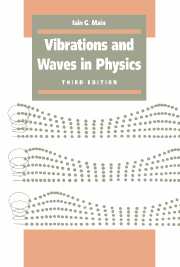Book contents
- Frontmatter
- Contents
- Preface to the first edition
- Preface to the second edition
- Preface to the third edition
- Notes for reference
- 1 Free vibrations
- 2 Free vibrations in physics
- 3 Damping
- 4 Damping in physics
- 5 Forced vibrations
- 6 Forced vibrations in physics
- 7 Anharmonic vibrations
- 8 Two-coordinate vibrations
- 9 Non-dispersive waves
- 10 Non-dispersive waves in physics
- 11 Fourier theory
- 12 Dispersion
- 13 Water waves
- 14 Electromagnetic waves
- 15 De Broglie waves
- 16 Solitary waves
- 17 Plane waves at boundaries
- 18 Diffraction
- Answers to problems and hints for solution
- Constants and units
- Index
16 - Solitary waves
Published online by Cambridge University Press: 05 June 2012
- Frontmatter
- Contents
- Preface to the first edition
- Preface to the second edition
- Preface to the third edition
- Notes for reference
- 1 Free vibrations
- 2 Free vibrations in physics
- 3 Damping
- 4 Damping in physics
- 5 Forced vibrations
- 6 Forced vibrations in physics
- 7 Anharmonic vibrations
- 8 Two-coordinate vibrations
- 9 Non-dispersive waves
- 10 Non-dispersive waves in physics
- 11 Fourier theory
- 12 Dispersion
- 13 Water waves
- 14 Electromagnetic waves
- 15 De Broglie waves
- 16 Solitary waves
- 17 Plane waves at boundaries
- 18 Diffraction
- Answers to problems and hints for solution
- Constants and units
- Index
Summary
Our examination of various waves in the previous three chapters has highlighted a fact of great practical significance: most wave systems are dispersive. The chief characteristic of a dispersive system is that it distorts any travelling waves that are not sinusoidal (section 12.1). Sinusoidal waves are not very useful, since they cannot carry any information other than their frequency and amplitude: one is usually interested in sending signals as some kind of modulated wave, and in particular as a train of pulses. Such an enterprise might appear doomed to failure if the chosen wave system is a dispersive one.
The remarkable fact is, however, that dispersive systems can after all support the undegraded propagation of stable pulses of a special kind, known as solitary waves. The effective cancellation of the dispersion has a surprising source in another property of most real wave systems, namely non-linearity.
To see how this comes about, we must first learn how non-linearity on its own affects a wave system. To simplify the discussion, we shall consider in this chapter only travelling plane waves moving in the positive z-direction, and we shall also neglect all non-conservative processes like friction and viscosity, which dissipate energy.
Non-linear wave systems
In chapter 7 we examined free and forced vibrations of non-linear systems.
- Type
- Chapter
- Information
- Vibrations and Waves in Physics , pp. 287 - 298Publisher: Cambridge University PressPrint publication year: 1993



